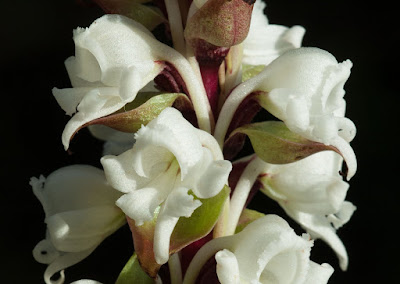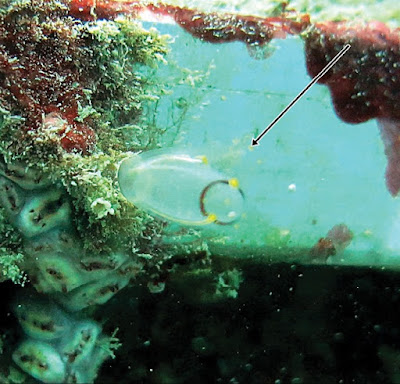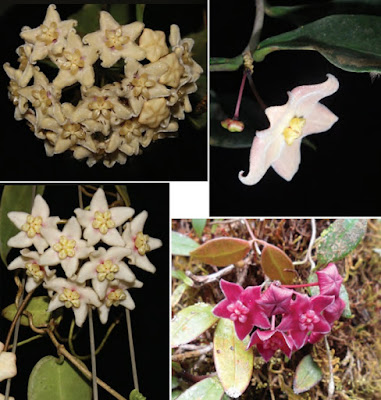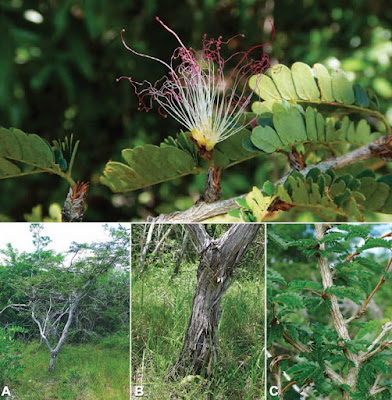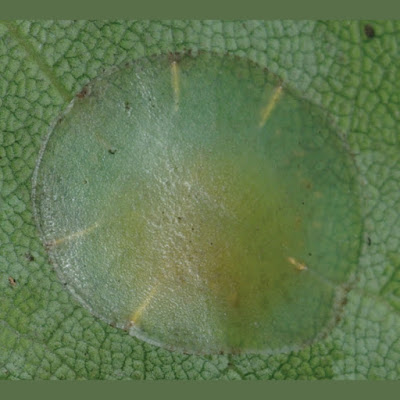[Most Recent Entries] [Calendar View]
Tuesday, May 30th, 2017
| Time | Event | ||||
| 1:04a | [Botany • 2017] Satyrium liltvedianum • A Newly Discovered Orchid Species from the Kogelberg Mountains of the Cape Floristic Region, South Africa
Highlights • A new orchid species was discovered in the well-botanised Kogelberg Mountains. • The new species was not present among historical museum collections. • The new species resembles other Satyrium species, but is phylogenetically distinct. • The compound β-Linalool dominates the floral scent, indicative of moth pollination. Abstract Individuals of plant populations with traits which are inconsistent with any existing species description may represent intraspecific variants, products of hybridisation, or a novel species. To distinguish among these possibilities for a population of unusual Satyrium individuals from the Kogelberg Mountains in the Cape Floristic Region (CFR), morphological traits and floral scent were documented, and phylogenetic analyses implemented. Plants from the Kogelberg population were characterised by long-spurred white flowers and a bifid rostellum. Floral scent was dominated by the common floral monoterpene volatile β-linalool. Although these traits characterise several southern African members of the genus, DNA sequences from the nuclear and plastid genomes of an accession from the Kogelberg population were highly distinct from other Satyrium species. The Kogelberg accession occupied an isolated phylogenetic position within the ‘Satyrium clade’ and was not sister to any other species with similar traits. There was weak support for membership of a clade of species with which plants from the Kogelberg population share the possession of lateral sepals that project at a perpendicular angle to the median sepal, and cover the side of the labellum, and which also produce β-linalool as dominant scent compound. Given the congruence of phylogenetic relationships inferred from plastid and nuclear DNA sequences respectively, a hybrid status of the Kogelberg population was rejected. Based on these results, the new species, Satyrium liltvedianum, which is uniquely characterised by the size, shape and orientation of sepals and lateral petals, is described in this study. Other Satyrium species with similar floral traits are pollinated by crepuscular moths, which therefore can also be inferred for the new species. A dichotomous key to the white-flowered, long-spurred Satyrium species of South Africa is provided. The restricted distribution range, a typical phenomenon for many CFR plant species, in combination with the isolated phylogenetic position, suggests that S. liltvedianum represents a palaeoendemic species. Keywords: β-Linalool; Moth pollination; Orchidaceae; Palaeoendemic; Floral scent Satyrium liltvedianum Van der Niet sp. nov. is morphologically similar to S. candidum, but differs from this species by having lateral sepals that overlap with the outside surface of the labellum and project at a ninety-degree angle from the median sepal instead of projecting from the same plane, and lateral sepals and petals that are approximately equal in size instead of smaller lateral petals than lateral sepals, and a median sepal that is narrower and longer than the lateral sepals instead of more or less similarly-sized. TYPE.— Western Cape Province, 3418 (Somerset West): Steenbras Catchment area near Rockview Dam, Kogelberg Mountains (–BB), 18 Nov 2009, W.R. Liltved 120 (NBG, holo.). Distribution: S. liltvedianum is known from a single population in the Steenbras Catchment area of the Kogelberg Mountains. Etymology: This species is named in honour of William Rune Liltved (1960–) who, over the past two decades, has made an invaluable contribution to recording the orchids of the Cape Floristic Region. This work culminated in publication of the book, The Cape Orchids ( Liltved and Johnson, 2012). Conservation status: Similar to several other orchids from the CFR, S. liltvedianum is known only from a single localised population of about 50 individuals (Linder and Kurzweil, 1999). The species is therefore considered highly vulnerable. Conclusion: There are many reasons why efforts to discover and describe species should be ongoing. Only recognised taxa can be adequately conserved; the success of scientific research often depends on sound taxonomic classification; beneficial properties of species can only be communicated if a species has a formal name; and recently Dijkstra (2016) argued that because naming species is inherent to human nature, continued exploration for the vast majority of species that are still unknown will improve our consciousness of the natural world. Much of Earth's biotic diversity is currently highly threatened and many species are on the brink of extinction, or have recently gone extinct (Wake and Vredenburg, 2008; Barnosky et al., 2011; McCallum, 2015), which provides a great sense of urgency to taxonomic enterprise. Several studies, including this study, have shown that new species are regularly still discovered in the field (e.g. Linder and Hitchcock, 2006 ; Steiner, 2011). Therefore, taxonomy cannot solely rely on historical herbarium or museum collections, even from within relatively well-botanised areas such as the Kogelberg Biosphere Reserve of the CFR, only 70 km from the city of Cape Town. T. Van der Niet. 2017. Satyrium liltvedianum: A Newly Discovered Orchid Species from the Kogelberg Mountains of the Cape Floristic Region (South Africa). South African Journal of Botany. 111; 126-133. DOI: 10.1016/j.sajb.2017.03.018 New species named after the man who co-wrote the ultimate Cape orchid book http://scibraai.co.za/new-species-named-a | ||||
| 2:17p | [Tunicata • 2017] Rhopalaea bilobata • A New Species of Sea Squirt (Ascidiacea: Diazonidae) from the Andaman Islands, India
Abstracts Rhopalaea bilobata, a new species of the class Ascidiacea, under the family Diazonidae has been described from the Andaman Islands of Andaman & Nicobar, India. The species was found in sandy bottoms, reef areas and artificial structures at a depth range of 10–40 m. This species has bilobed anal border, six lobed branchial and atrial siphons, transparent thorax with pigmented spots at the anus, between the two siphons and at the anterior end of endostyle, and ramified basal test. The species is closely related to R. idoneta, R. macrothorax and R. tenuis in several sets of anatomical and morphological features. Keywords: Anal border, Andaman & Nicobar Islands, Ascidians, Rhopalaea, Tunicata. Etymology: The species bears distinctive triangular bilobed anal border. Distribution: India: Havelock Island, Trilby Island and Pongibalu of Andaman Islands. Jhimli Mondal, C. Raghunathan and Tamal Mondal. 2017. A New Species of Sea Squirt, Rhopalaea bilobata (Ascidiacea: Diazonidae) from the Andaman Islands, India. Journal of Threatened Taxa. 9(5); 10187–10193. DOI: 10.11609/jott.2620.9.5.10187-10193 | ||||
| 2:38p | [Botany • 2017] A Revision of Hoya (Apocynaceae: Asclepiadoideae) of Papuasia. Part I: Ten New Species, One New Subspecies and One New Combination ABSTRACT The large majority of Hoya R.Br. species known from Papuasia were described in the first half of the 20th century and most of these are endemic. Along with Borneo and the Philippines the region is a centre of diversity of the genus. Since 2006 herbarium materials have been studied for a revision of Hoya of New Guinea along with field investigations on Papuasian Hoya since 2010. In the present paper we publish ten new species, Hoya brassii P.I.Forst. & Liddle ex Simonsson & Rodda, H. carrii P.I.Forst. & Liddle ex Simonsson & Rodda, H. edholmiana Simonsson & Rodda, H. evelinae Simonsson & Rodda, H. juhoneweana Simonsson & Rodda, H. krusenstierniana Simonsson & Rodda, H. koteka Simonsson & Rodda, H. stenakei Simonsson & Rodda, H. versteegii Simonsson & Rodda and H. yvesrocheri Simonsson & Rodda, one subspecies, H. juhoneweana ssp. lindforsiana Simonsson & Rodda, and make one new combination, H. urniflora (P.I.Forst.) Simonsson & Rodda, which is also lectotypified. Keywords: Indonesia, Marsdenieae, Papua New Guinea  Hoya brassii P.I.Forst. & Liddle ex Simonsson & Rodda, sp. nov. Etymology. Named after Leonard John Brass (1900–1971), an Australian botanist who collected the type specimen in 1936 on the Fly River Expedition of the American Museum of National History (the second Archbold New Guinea Expedition). Hoya carrii P.I.Forst. & Liddle ex Simonsson & Rodda sp. nov. Etymology. Named after C. E. Carr (1892–1936), who first collected the taxon in 1935, and again in 1936, on a collecting expedition supported by the British Museum, London, which started in 1934. He died of malaria in June 1936, just a few months after discovering the second locality of Hoya carrii. Hoya edholmiana Simonsson & Rodda, sp. nov. Etymology. Named after the siblings Charlize, Diesel and Evelize Edholm of Sweden, supporters of the first author’s work in PNG. Hoya evelinae Simonsson & Rodda, sp. nov. Etymology. Named after the late Mrs Evelina Eriksson (1932–2009) of Sweden who supported the first author’s work in PNG. Hoya juhoneweana Simonsson & Rodda, sp. nov. subsp. juhoneweana Etymology. Named after the first author’s colleague, Foreting Juhonewe, who is also from Hoboc village. He has been of great importance for this research. He has eagerly tried to find more of this rare and diminishing Hoya and promoted its conservation in situ amongst his clan’s people. Hoya juhoneweana subsp. lindforsiana Simonsson & Rodda, subsp. nov. Etymology. Named after Constantinus Lindfors in Sweden, a supporter of the first author’s work in PNG. Hoya krusenstierniana Simonsson & Rodda, sp. nov. Etymology. Named after the Krusenstiern family, supporters of the first author’s work in PNG. Hoya koteka Simonsson & Rodda, sp. nov. Etymology. Named after its elongated style-head that resembles the traditional koteka, or penis-gourd traditionally worn by male natives of New Guinea. Hoya stenakei Simonsson & Rodda, sp. nov. Etymology. Named after the late Mr Sten-Åke Svensson (1947 – 2011) of Sweden, whose children supported the first author’s work in PNG. Hoya versteegii Simonsson & Rodda, sp. nov. Etymology. Named after its collector, G. Versteeg (1876–1943). Hoya yvesrocheri Simonsson & Rodda, sp. nov. Etymology. Named after the Yves Rocher Foundation which supported the first author’s Hoya Project for five years during 2011–2015. N. Simonsson Juhonewe and M. Rodda. 2017. Contribution to A Revision of Hoya (Apocynaceae: Asclepiadoideae) of Papuasia. Part I: Ten New Species, One New Subspecies and One New Combination. Gardens’ Bulletin Singapore. 69(1); 97–147. | ||||
| 3:17p | [Botany • 2017] Calliandra mayana • A New Narrowly Endemic Species (Leguminosae, Mimosoideae) from Campeche, Mexico
Abstract A new species of Calliandra (Leguminosae, Mimosoideae, tribe Ingeae) from a restricted locality of Campeche, Mexico is herein described and illustrated. The species appears to be closely related to C. molinae, a species from Honduras, El Salvador and Nicaragua, from which it may be distinguished by being allopatric, and by a more limited development of suberose bark in stems and branches, comparatively smaller leaflets, consistently glabrous leaflets and corollas, and by the scarcely villous pods. Calliandra mayana appears to be restricted to an extremely small seasonally flooded savannah surrounded by tropical deciduous forest and, based on IUCN criteria, it is provisionally considered Critically endangered. Keywords: Calakmul, Calliandra belizensis, Fabaceae, Flora Mesoamerica, legumes, Eudicots Calliandra mayana H.M. Hern., sp. nov. Calliandra mayana is closely related to C. molinae from which may be distinguished by being smaller shrubs up to 4 m (vs. 7 m), by the branchlets with bark slightly suberose (vs. thickly suberose), by the smaller petioles, rachis, rachillae and leaflets and less numerous pairs of pinnae and leaflets (vs. leaf parts larger and more numerous), and by the glabrous leaflets and corollas (vs. pubescent leaflets and villous corollas). Type:— MEXICO. Campeche, municipality Hopelchén, 9 km S of Pachuitz, 20 August 2016 (fl), H.M. Hernández et al. 4122 (holotype: MEXU 1446712!; isotypes: CICY!, ENCB!, K!, MEXU!, MO!, NY!, TEX!, US!, XAL!). Etymology:— This species in named to honour the Maya, an indigenous people that has continuously inhabited parts of south-eastern Mexico and Central America during several millennia. The Maya civilization flourished in the Yucatan Peninsula, Chiapas, Guatemala and Belize, and the western portions of Honduras and El Salvador, from 2000 BC to 950 AD. Distribution and habitat:— Calliandra mayana is currently known only from an extremely small seasonally flooded savannah area surrounded by forest in Calakmul, eastern Campeche, Mexico, close to the Quintana Roo border, at 80 meters elevation (Figure 4). The Calakmul area is the largest tract of well-preserved tropical deciduous and sub-deciduous forest in Mesoamerica. Héctor M. M. Hernández and Carlos Gómez-Hinostrosa. 2017. Calliandra mayana (Leguminosae, Mimosoideae), A New Narrowly Endemic Species from Campeche, Mexico. Phytotaxa. 307(4); 278–284. DOI: 10.11646/phytotaxa.307.4.5 | ||||
| 3:44p | [Entomology • 2017] Austrolecanium cryptocaryae • A Newly Recognised Australian Endemic Species of Austrolecanium Gullan & Hodgson 1998 (Hemiptera: Coccidae) from Queensland
Abstract Austrolecanium cryptocaryae Lin & Cook sp. n. is described based on adult female morphology and DNA sequences from mitochondrial and nuclear loci. This Australian endemic species was found on the underside of leaves of Cryptocarya microneura (Lauraceae) in Queensland. All phylogenetic analyses of four independent DNA loci and a concatenated dataset show that A. cryptocaryae is monophyletic and closely related to A. sassafras Gullan & Hodgson, the type species of Austrolecanium Gullan & Hodgson. The adult female of A. cryptocaryae is described and illustrated and a table is provided of the characters that differ among adult females of the three species of Austrolecanium currently recognised (A. cappari (Froggatt), A. cryptocaryae sp. n. and A. sassafras). Keywords: Coccomorpha, Coccoidea, Paralecaniini, Cryptocarya, COI DNA barcode, taxonomy, Hemiptera, Queensland
Etymology. The other two species of Austrolecanium are named after their host plants, so we continue this tradition here. The species epithet cryptocaryae is derived from the genus name of the host plant, Cryptocarya microneura, and means "of Cryptocarya". Yen-Po Lin, Zheng Y. Ding, Penny J. Gullan and Lyn G. Cook. 2017. A Newly Recognised Australian Endemic Species of Austrolecanium Gullan & Hodgson 1998 (Hemiptera: Coccidae) from Queensland. Zootaxa. 4272(1); 119–130. DOI: 10.11646/zootaxa.4272.1.6 |
| << Previous Day |
2017/05/30 [Calendar] |
Next Day >> |


